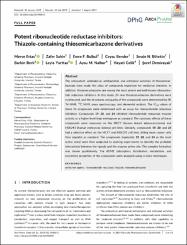Potent ribonucleotide reductase inhibitors: Thiazole-containing thiosemicarbazone derivatives

View/
Access
info:eu-repo/semantics/closedAccessDate
2019Author
Ertas, MerveSahin, Zafer
Bulbul, Emre F.
Bender, Ceysu
Biltekin, Sevde N.
Berk, Barkin
Demirayak, Seref
Metadata
Show full item recordAbstract
The antioxidant, antimalarial, antibacterial, and antitumor activities of thiosemicarbazones have made this class of compounds important for medicinal chemists. in addition, thiosemicarbazones are among the most potent and well-known ribonucleotide reductase inhibitors. in this study, 24 new thiosemicarbazone derivatives were synthesized, and the structures and purity of the compounds were determined by IR, H-1 NMR, C-13 NMR, mass spectroscopy, and elemental analysis. the IC50 values of these 24 compounds were determined with an assay for ribonucleotide reductase inhibition. Compounds 19, 20, and 24 inhibited ribonucleotide reductase enzyme activity at a higher level than metisazone as standard. the cytotoxic effects of these compounds were measured on the MCF7 (human breast adenocarcinoma) and HEK293 (human embryonic kidney) cell lines. Similarly, compounds 19, 20, and 24 had a selective effect on the MCF7 and HEK293 cell lines, killing more cancer cells than cisplatin as standard. the compounds (especially 19, 20, and 24 as the most active ones) were then subjected to docking experiments to identify the probable interactions between the ligands and the enzyme active site. the complex formation was shown qualitatively. the ADME (absorption, distribution, metabolism, and excretion) properties of the compounds were analyzed using in-silico techniques.

















